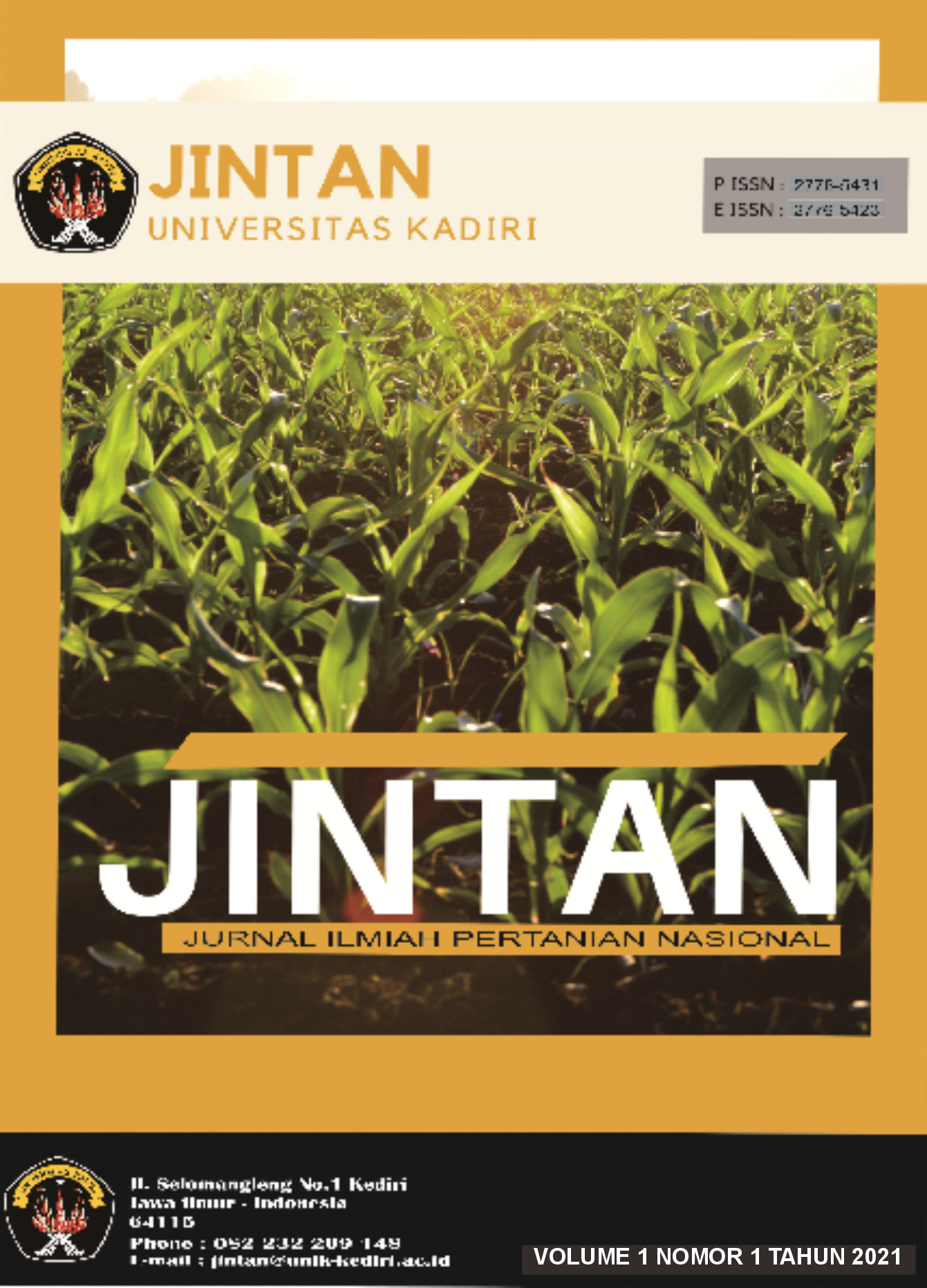Pengaruh Konsentrasi dan Interval Pemberian Pupuk Daun Terhadap Pertumbuhan dan Produksi Kacang Panjang (Vigna sinensis L)
DOI:
https://doi.org/10.30737/jintan.v1i1.1381Keywords:
Asparagus beans, Concentration, Foliar fertilizer, ProductionAbstract
The objective of this study was to understand the effect of the concentration and interval of foliar fertilizer application on the growth and production of asparagus bean (Vigna sinensis L.). This research was conducted from November 2019 to January 2020 in Karangrejo Village, Garum District, Blitar Regency on the experimental field with an altitude of 300 meters above sea level. The study used a randomized block design (RBD), consisted of 2 (two) factors. The first factor was the concentration of foliar fertilizer (K), which consisted of 3 levels, namely: 0.5 gram/litre water (K1), 1.0 gram/litre water (K2), and 1.5 gram/litre water (K3). The second factor was the interval of foliar fertilizer application, which consists of 3 levels, namely: 10; 15, and 20 days after planting. In this study, there were nine treatment combinations with three replications. Observation parameters include plant length, number of leaves, leaf area, gross weight of each plant, number of fruit per plant, and gross weight of each plant plot. The results showed that there was an interaction between the concentration and the interval of foliar fertilizer application on the fruit wet weight of each plant, the number of fruits per plant, and the gross weight of each plant plot. The treatment combination between the concentration of 1.5 grams/litre of water and the interval of foliar fertilizer application at 20 days after planting (K3I3) gave the best results. The concentration of foliar fertilizers affected plant length, gross weight per plant, number of fruit per plant, and gross weight per plant plot.
Â
Tujuan dari penelitian ini adalah untuk mengetahui pengaruh konsentrasi dan interval pemberian pupuk daun terhadap pertumbuhan dan produksi kacang panjang (Vigna sinensis L.). Penelitian ini dilaksanakan pada bulan Nopember 2019 sampai dengan Januari 2020 di Desa Karangrejo Kecamatan Garum Kabupaten Blitar pada tanah sawah dengan ketinggian tempat 300 meter dari permukaan laut. Penelitian menggunakan Rancangan Acak Kelompok (RAK) yang terdiri dari 2 (dua) faktor. Faktor pertama adalah konsentrasi pupuk daun (K) yang terdiri dari 3 taraf yaitu: 0,5 gram/liter air (K1), 1,0 gram/liter air (K2), dan 1,5 gram/liter air (K3). Faktor kedua adalah interval pemberian pupuk daun yang terdiri dari 3 taraf yaitu: 10; 15 dan 20 hari setelah tanam (HST). Pada penelitian ini terdapat 9 kombinasi perlakuan dengan 3 (tiga) kali ulangan. Parameter pengamatan meliputi: panjang tanaman, jumlah daun, luas daun, berat basah buah tiap tanaman, jumlah buah tiap tanaman, dan berat basah buah tiap plot tanaman. Hasil penelitian menunjukkan bahwa terjadi interaksi antara konsentrasi dan interval pemberian pupuk daun terhadap berat basah buah tiap tanaman, jumlah buah tiap tanaman dan berat basah buah tiap plot tanaman. Kombinasi perlakuan antara konsentrasi 1.5 gram/liter air dan interval pemberian pupuk daun pada 20 setelah tanam (K3I3) memberikan hasil yang terbaik. Konsentrasi pupuk daun berpengaruh terhadap panjang tanaman, berat basah buah tiap tanaman, jumlah buah tiap tanaman dan berat basah buah tiap plot tanaman.
References
Bastianus Zaevi, Marisi Napitupulu, dan P. A. (2014). Respon Tanaman Kacang Panjang (Vigna sinensis L.) Terhadap Pemberian Pupuk NPK Pelangi Dan Pupuk Organik Cair NasaNo Title. AGRIFOR.
BPS-Provinsi Jawa Timur. (2018). Provinsi Jawa Timur dalam Angka 2018. BPS Provinsi Jawa Timur, 404.
Haryanto, E., Suhartini, T., & Rahayu, E. (2007). Budidaya Kacang Panjang. Penebar Swadaya.
Litbang, B., Hutan, K. P., Konservasi, D., & Bogor, A. (2013). Tanah. Buku. Armico. Bandung. Buku. Raja Grafindo Persada. Jakarta. Rancangan Percobaan Teori Dan Aplikasi. Buku. PT. Raja Grafindo Persada. Jakarta. Ilmu Tanah. Buku. Akademika Pressindo. Jakarta. Indriyanto. Pengantar Budi Daya Hutan. Buku. PT Bumi Aksara. Jak.
Mastuti, R. (2016). Fisiologi Tumbuhan. Universitas Brawijaya.
Santoso, B. B. (2011). Dasar-dasar hortikultura. Dasar-Dasar Hortikultura.
Saptorini, Supandji, & Taufik. (2019). Pengujian pemberian pupuk za terhadap pertumbuhan dan produksi tanaman bawang merah varietas bauji. Agrinika, 3(2), 76–81.
Simarmata, E. R., Ardian, & Sa’diyah, N. (2015). Penampilan karakter produksi kacang panjang (Vigna sinensi L.) generasi F1 dan tetuanya. Jurnal Agrotek Tropika.
Subagiartha, I. M. (2018). Sel Struktur, Fungsi, dan Regulasi. Anesthesiologi Dan Terapi Intensif.
Supandji. (2018). Pengaruh Dosis Pupuk N P K Dan Beberapa Varietas Terhadap Pertumbuhan Dan Produksi Beberapa Varietas Tanaman Kacang Panjang. Agrinika.
Downloads
Published
How to Cite
Issue
Section
License
Authors who publish in this journal agree to the following terms:
- Authors retain copyright and grant the journal right of first publication with the work simultaneously licensed under a Creative Commons Attribution License (https://creativecommons.org/licenses/by-nc-nd/4.0/) that allows others to share the work with an acknowledgment of the work's authorship and initial publication in this journal. Permitted third party reuse is defined by the Creative Commons Attribution-NonCommercial-NoDerivs (CC BY-NC-ND). This permission allows users to copy and distribute the Article, provided this is not done for commercial purposes and further does not permit distribution of the Article if it is changed or edited in any way, and provided the user gives appropriate credit (with a link to the formal publication through the relevant DOI), provides a link to the license, and that the licensor is not represented as endorsing the use made of the work.
- Authors are able to enter into separate, additional contractual arrangements for the non-exclusive distribution of the journal's published version of the work (e.g., post it to an institutional repository or publish it in a book), with an acknowledgment of its initial publication in this journal.
- Authors are permitted and encouraged to post their work online (e.g., in institutional repositories or on their website) prior to and during the submission process, as it can lead to productive exchanges, as well as earlier and greater citation of published work.
- For open-access publishing, authors have the right to share their articles in the same ways permitted to third parties under the relevant user license, as well as certain scholarly usage rights.




